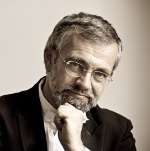The feeling was akin to meeting with old friends after a long absence. Only a few days after Elijah Moshinsky's brilliant 1991 production of Rigoletto had been restaged at the Sydney Opera House, another magnificent Verdi opera, Aida, has been revived by Opera Australia in the same hall. In such close proximity, the contrasts between the directorial approaches of the two masterworks were startling.
With its extensively digitised set, Davide Livermore’s Aida created a lot of excitement in 2018. With his regular collaborators Giò Forma and D-Wok, he completely reimagined the concept of contemporary opera production (at least, in Sydney), mostly relying on the smooth and virtuosic movements of ten enormous LED panels, which move in all directions, offering arresting video images of giant snakes, Egyptian hieroglyphs, stormy clouds and the like.
These video panels are strikingly colourful and imposing in both size and versatility, but with the novelty effect waning, they feel less impressive now than five years ago. For one thing, they reduce the dramatic effect of the opera by offering a simplified version of what Richard Wagner had achieved with his complex Leitmotif system. When Amneris is alone on stage, by way of example, a giant, black panther blinks and nods behind her, the comparison to her ruthless nature all too obvious (although, according to Verdi’s brilliant opera, this is not quite so simple). An even greater problem with this production is that apart from the video images – and after a while, the threatening volcanic clouds projected there become all too familiar – there is little else happening.
The staging itself is static and, perhaps due to an over-reliance on the impact of the projections, the acting is almost completely absent. Yet Aida, Verdi’s response to French Grand Opéra, should be a spectacle in all of its elements. The impression left here is a lack of faith in the talents of human actor-singers in preference to digital images – a lamentable trade-off. After numerous harrowing and brilliant OA productions by William Kentridge, Barrie Kosky and, indeed, Moshinsky to name but a few, the all but motionless tableaux of the Egyptian hierarchy in the first two acts, notwithstanding Gianluca Falaschi’s eye-catching costumes, provoke little excitement.
These scenes are designed in a highly symmetrical fashion, which makes the frequent appearance of nine dancers (five on one side, four on the other) odd. In opera, balance and ensemble is imperative, and the movements of these dancers were coordinated with less than perfect unity. In Act 2’s much loved Triumphal March, their actions reminded one neither of triumph, nor of a march, moving between simple balletic movements and spasmodic gestures, and their breathless “war cries” were hardly worthy of the best traditions of this house.
Fortunately, the quality of singing was uniformly high. This became most obvious in the duet and trio scenes of the last two acts. Leah Crocetto, as the eponymous Ethiopian slave, presented subtle dynamic contrasts in her effortless and refined soprano. Why her gentle prayer at the end of “Ritorna vincitor” was accompanied by threatening red clouds on the screens was unclear; at any rate, her “O patria mia” expressed passion and loving pain. The highlight of the evening was Aida's duet with her father, Amonasro. Warwick Fyfe has a long history with this role; he understands the captured king’s internal torments and expressed them with vocal emotions and physical gestures, his Italian articulation clear and his voice authoritative.
As Radamès, Uzbek tenor Najmiddin Mavlyanov did not immediately find heroic warmth. The end of “Celesta, Aida” came out neither softly nor morendo (dying away), as instructed by the composer, but vocally he improved later on and in the final, petrifying tomb scene, he became an equal partner to Crocetto’s touching singing.
Of the other royal father-daughter pair, Elena Gabouri’s beautiful voice dramatically expressed Amneris' boundless jealousy, although her regular darkening of her lower register became mannered after a while. David Parkin, as her father, his costume oddly resembling a medieval Crusader more than an Egyptian King, delivered his lines accurately from his disadvantaged position. Roberto Scandiuzzi presented Ramfis’s zeal and menace with an appropriately dark tone, unaided by an over-generous vibrato.
So much depends on the orchestra and its leader in this opera. Curiously, while the playing was uniformly dependable, very little power radiated from the pit to support the singers. Stuart Stratford’s conducting, unerringly smooth, took very few risks and resulted in almost no tumultuous fortissimos, whether triumphant or tragic. The black panther nodded, but it did not strike.




